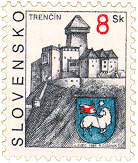 |
||
| Trenčín | ||
Catalogue Number: Stamp Design: Stamp Engraving: Date of Issue: Printing: Print Technology: Print Run: |
77 Ján ©vec Rudolf Cigánik September 12, 1995 Postal Stationery Printing House, Prague, Czech Republic Rotary-recess printing combined with recess printing indefinite |
| FDC Design: | Ján ©vec |
| FDC Engraving Design: | Rudolf Cigánik |
| Cancellation Design: | Ján ©vec |
| Printing: | Kníhtlač Gerthoffer, Zohor |
| Print Technology: | Offset |
| FDC Print Run: | 10,000 |
|
Ancient Trenčín and its castle - a National Cultural Monument - are a living testament to the most significant events and times in our nation´s history. Trenčin´s propitious location on a promontory over River Váh and at the crossroads of the old trading routes has determined the manner of settlement from the very earliest of times. The area of what is now Trenčín was of great importance during the period of Roman expansion. The settlement of Laugaricio was the northern-most point reached by the Roman armies, a fact borne out by an inscription hewn on the castle rock and dating from the year 179 A. D. In the 11th century the castle became the seat of a county (or "ľupa") of the Hungarian Monarchy. The stronghold´s most illustrious proprietors were the Čák family. Its most powerful member was Matúą Čák Trenčiansky, known as the "Lord of the Váh and the Tatras", who occupied the castle from 1296. A market community grew up in the shadow of the imposing fortress, and this later became a centre for trades and commerce. On February 19th 1412 Zigmund of Luxembourg elevated Trenčín to a free royal town. In later years the town witnessed all of the various rebellions staged by the lesser nobility. At the turn of the 18th and 19th centuries Trenčín and its surroundings were an important centre of Slovak national life. Today Trenčín is one of the most important towns in Slovakia. |
|
|
|
 |
|
||
| Copyright ©2000 askom | ||||